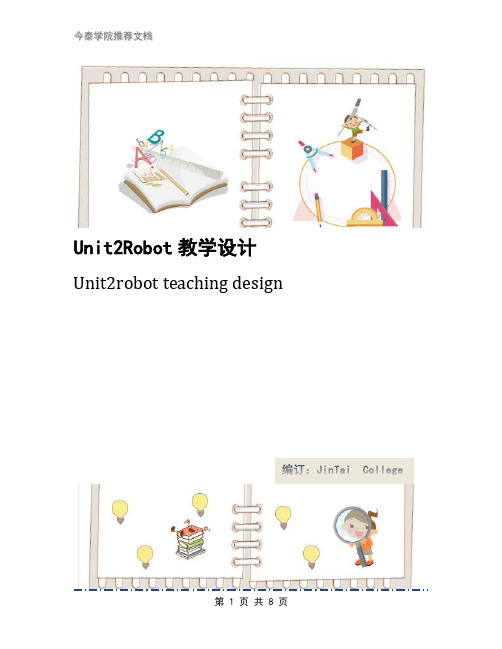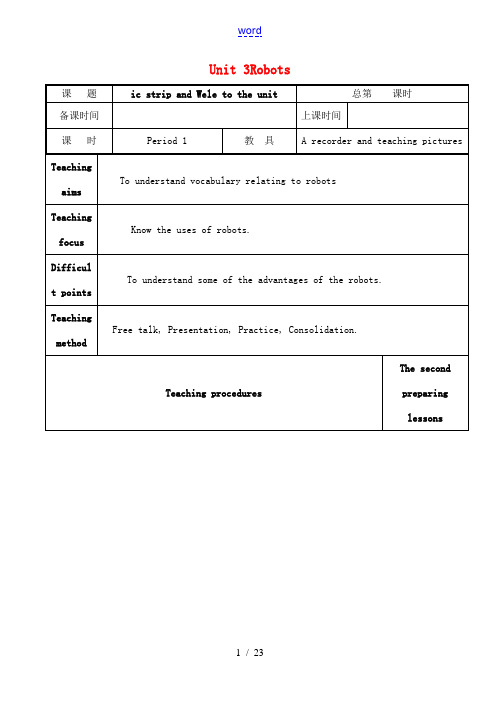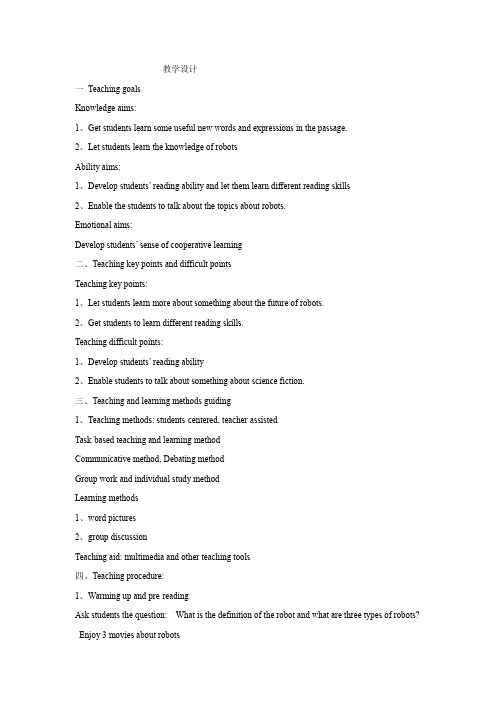Robot teaching 教材
- 格式:ppt
- 大小:6.60 MB
- 文档页数:23

unit2《robot》全套教案(牛津英语初三下)doc初中英语9B Unit 2 welcome to the unitI. Teaching objectives:1. To introduce the context about having a robot to help with the work for humans2. To talk about what a robot can do3. To learn some of the advantages of robotsII. Teaching procedure:Step 1: Warm-up: To raise students’ interest, get students thinking andtalking about robots:① Have you seen robots in the films?② What kind of robots do you know?③ Do you like robots? Why?④ What do you think robots can do for you?⑤ Would you buy a robot in the future? Why?Step 2: welcome to the unit1. The purpose of this part is to activate student’s knowledge ofrobots and generate interests of this topic. Ask one student to read thephrases in the word box at the top of page 19. Make sure that all students understand th e meanings of the phrases such as ‘do the laundry, explorer dangerous places’ in their own words.2. Explain the context. Daniel is explaining to Amy what robots cando. Ask students to complete the conversation on Page 19 on their own.3. Ask two students to read the conversation and check mistakes.4. Encourage students to talk about if robots are harmful? Dividestudents into groups to discuss.① What do robots do harm to human beings?② Why do they do harm to human beings?5. Listen to the tape for the first time to learn the main idea ofthe comic strip.6. Listen to the tape for the second time to read after the tape.7. Ask some students to act out the comic strip.Step 3: Useful expressions1. complaint: 不+可数名词〝埋怨〞;可数名词〝埋怨的行动或话,投诉〞complain: 动词:complain to / about2. post:动词‘邮寄’:. post something for sb.III. Homework:1. Recite the useful vocabulary and comic strip.2. Complete some exercise.3. Preview reading(1)教学小结:学生差不多能把握对话,明白得机器人能为人类做好多事。

Unit2Robot教学设计Unit2robot teaching designUnit2Robot教学设计前言:小泰温馨提醒,英语作为在许多国际组织或者会议上都是必需语言,几乎所有学校选择英语作为其主要或唯一的外语必修课。
英语教学涉及多种专业理论知识,包括语言学、第二语言习得、词汇学、句法学、文体学、语料库理论、认知心理学等内容。
本教案根据英语课程标准的要求和针对教学对象是初中生群体的特点,将教学诸要素有序安排,确定合适的教学方案的设想和计划、并以启迪发展学生智力为根本目的。
便于学习和使用,本文下载后内容可随意修改调整及打印。
一、基础词汇(n.)1.洗衣服的活2.推销员3.定单4.病毒5.垃圾箱6.混乱7.洗涤槽8.垃圾、废物9.中午10.电池11.轮子、车轮12.胸膛(v.)1.邮寄2.熨烫3.打扫、清扫4.展开,扩散5.倒空、腾空(adj.)1 脏的2.每日的___________3.干的____________(adv.)自由地二、重点词组1.第一个做……的人2.改变了许多 _____3.为了有更多的空闲时间4.熨烫衬衫 _____5.结果6.不再 _____7.睡在床上8.再多一小9.洗衣服10.洗盘子 _____11.扫地12.铺床 ____13.下班回家14.对……满意 ___15.准备16.出错 ____17.感染病毒18.制造许多麻烦 _____19.唤醒20.把东西撞翻 _____21.发现房间一团糟22.对付 _____23.最后24.太多的麻三、句型结构1.mr jiang is the first person in sunshine town to own a robot.(the first/second/last…to do)1)妇女和孩子们是第一个进入救生船的。
women andchildrenthe lifeboats2)张老师总是最后一个离开学校。
mrzhang alwaysschool.2.the robot was just too much trouble.注意:too much, much too, too many的含义及用法。


教学设计一Teaching goalsKnowledge aims:1、Get students learn some useful new words and expressions in the passage.2、Let students learn the knowledge of robotsAbility aims:1、Develop students’ reading ability and let them learn different reading skills2、Enable the students to talk about the topics about robots.Emotional aims:Develop students’ sense of cooperative learning二、Teaching key points and difficult pointsTeaching key points:1、Let students learn more about something about the future of robots.2、Get students to learn different reading skills.Teaching difficult points:1、Develop students’ reading ability2、Enable students to talk about something about science fiction.三、Teaching and learning methods guiding1、Teaching methods: students-centered, teacher-assistedTask-based teaching and learning methodCommunicative method, Debating methodGroup work and individual study methodLearning methods1、word pictures2、group discussionTeaching aid: multimedia and other teaching tools四、Teaching procedure:1、Warming up and pre-readingAsk students the question: What is the definition of the robot and what are three types of robots? Enjoy 3 movies about robots2、Scanning.: Listen to the mp3 and discuss the following questions①What is the text mainly about?②What did the robot called Tony look like?③How many characters are mentioned? Who are they? What is the relationship between them?3.Judge whether the following statements are true or false.(see the computer screen)4、Read the text silently again and fill in Claire’s feelings on the following occasions and pay attention to the change(see the computer screen)5、Multiple choice Choose the best answer. Read the text silently again and let the students find out the best answer(see the computer screen)6、Summary.(课文语法填空)7、Design a dialogue between Tony and Claire and act it out.①About when they just met each other.②About when Claire went shopping in the city.③About her friends went to her house for the party.8 、Homeworkg学情分析就我校而言,大多数学生经过高二上半学期的学习,在听说读写方面均有进步,但不平衡,有约百分之二十的学生对知识的理解和运用能力较强,能够比较准确地理解课文。

人教版高中英语选修7《Unit2Robots》教案人教版高中英语选修7《Unit 2 Robots》教案【一】教学准备教学目标Teaching goals 教学目标1. Be able to learn some important words and phrases2.Help students to learn about robots and science fiction教学重难点eaching important points教学重点Enable students to grasp what T ony did to help Claire and how her emotion developed during Tony’s stay at her house.Teaching dif ficult points 教学难点How Claire’s emotion developed during Tony’s stay at her house.教学过程Teaching procedures 教学过程Step I Warming upPresent a photo of robots. Then ask students to say something about robot.What is on the blackboard?What is a robot?What can a robot do?Step II Pre-readingAsk students to predict question:If you have a robot, will you fall in love with it ?Introduce the background of the text.Step III ReadingFast reading1.What is the text mainly about?It is mainly about how a household _________ was _________ ________ in a family.2.Find the characters in the storyLarry Belmont: working in a company that makes robotsClaire: Larry’s wife, a housewifeTony: the robotGladys Claffern: a woman that Claire envies3. Tell stu dents that Claire’s feelings towards Tony changed as the story developed. Read the story again and then fill in the blanks.Comprehensio nRead the sto ry again and find out Claire’s sense of failure and what helps did Tony offer to her.SummaryFill in the blanks according to the knowledge that we have learnt in this class.The company for which Larry worked was to have a newly?made robot____(call)Tony experimented with by his wife Claire at home. At _____first sight of Tony, Claire felt ________(alarm). She thought it was absurd tha t a robot seemed more like a human than a ______ .For as long as three weeks, Tony wanted to help her to dress, which made Claire ________(embarrass) and she refused him. But she was glad that Ton y could make her home ________, give her a new h aircut and change her makeup. To improve her home,he could also ________ a list of items for her to buy. And finally Tony helped Claire win the victory to be ________ (envy)by those ladies like Gladys Claffern who Claire wanted to be like. ________made us unbelievable was that Claire fell in love ______Tony—a robot !课后习题Homework1. Surf the Internet to get more information about science fiction..2. Preview the language points in the text.人教版高中英语选修7《Unit 2 Robots》教案【二】教学准备教学目标教学目标1. 语言知识: 使学生理解文章中表达情感变化词汇;熟悉有关机器人方面的话题。

人教版高中英语Unit 2 Robots教案2023Unit 2 Robots – Lesson Plan 2023I. Introduction- Greetings and warm-up activity: Ask students if they have ever interacted with robots or have any knowledge about robots.- Engage students in a brief discussion about the use of robots in today's society.- Present the lesson objectives: to explore the topic of robots, understand their impact on society, and practice relevant vocabulary and grammar.II. Vocabulary- Introduce key vocabulary related to robots: artificial intelligence, automation, humanoid, prototype, etc.- Use real-life examples and visuals to help students understand the meanings of the words.- Engage students in activities such as matching exercises, fill in the blanks, or creating sentences using the new vocabulary.III. Reading Comprehension- Provide students with a reading passage from the textbook (Unit 2, Robots) that discusses the benefits and risks of using robots in various industries.- Have students read the passage individually, and then in pairs or small groups, discuss their understanding of the text.- Facilitate a class discussion to check comprehension and address any questions or uncertainties.IV. Listening Activity- Play an audio recording or video related to robots, such as an interview with an expert or a news report on the latest advancements in robotics.- Provide students with a set of comprehension questions related to the listening activity.- Allow students to discuss their answers in pairs or small groups before sharing their responses with the whole class.V. Grammar Focus: Modals of Obligation and Permission- Introduce and explain the grammar point of modals of obligation and permission using examples related to robots.- Provide students with guided exercises to practice using modals of obligation and permission in context.- Offer additional examples for students to create their own sentences using the target grammar.VI. Speaking Practice: Role Play- Divide students into pairs or small groups and assign each group a specific scenario involving robots.- Instruct students to create a dialogue using the target vocabulary and grammar from the lesson.- Encourage students to engage in realistic conversations and apply their knowledge of robots and the related vocabulary.VII. Writing Activity- Assign a writing task where students need to imagine and describe a future world in which robots play a significant role.- Encourage students to use vocabulary, grammar, and ideas discussed throughout the lesson.- Provide a word count requirement to ensure students write an adequate amount of content.VIII. Review and Wrap-up- Conduct a quick review of the key points covered in the lesson, such as vocabulary, grammar, and the impact of robots in society.- Allow students to ask any remaining questions or share their thoughts and reflections on the topic.- Provide a short summary of the lesson and remind students of the importance of understanding and embracing advancements in technology.IX. Homework- Assign homework tasks related to the lesson, such as completing a vocabulary exercise, writing a reflection paper on robots, or researching a specific robot innovation.Note: This lesson plan is designed for the Unit 2 Robots in the People's Education Press (人教版) high school English textbook. However, it can be adapted to other textbooks and teaching materials as necessary.。
牛津译林版九年级下册Unit 3《Robot》教学设计7一. 教材分析本课选自牛津译林版九年级下册Unit 3《Robot》,本课的主题是关于机器人的特点和功能。
通过本课的学习,学生能够掌握有关机器人的词汇和表达方式,并运用所学知识进行简单的交流和描述。
教材通过生动的图片和情境,激发学生的学习兴趣,培养学生的观察力和想象力。
二. 学情分析九年级的学生已经具备了一定的英语基础,对于日常生活中的词汇和句子能够进行简单的交流。
但部分学生对于较为复杂的内容和抽象的概念理解起来较为困难,因此,在教学过程中需要针对不同学生的学习情况进行有针对性的引导和帮助。
三. 教学目标1.知识目标:学生能够掌握有关机器人的词汇和表达方式,了解机器人的特点和功能。
2.能力目标:学生能够运用所学知识进行简单的交流和描述,提高口语表达能力。
3.情感目标:通过学习,学生能够培养对科学和技术的兴趣,增强创新意识。
四. 教学重难点1.重点:学生能够掌握有关机器人的词汇和表达方式,了解机器人的特点和功能。
2.难点:学生能够运用所学知识进行简单的交流和描述,特别是对于一些抽象的概念和表达方式。
五. 教学方法1.情境教学法:通过生动的图片和情境,激发学生的学习兴趣,提高学生的观察力和想象力。
2.交际法:通过分组讨论和角色扮演等活动,让学生在实际语境中运用所学知识进行交流和描述。
3.任务型教学法:通过完成具体任务,培养学生独立思考和合作学习的能力。
六. 教学准备1.教师准备:备好相关教学材料和课件,提前布置预习任务。
2.学生准备:学生提前预习教材,了解基本内容。
七. 教学过程1.导入(5分钟)教师通过展示一些机器人的图片,引导学生谈论关于机器人的话题,激发学生的学习兴趣。
2.呈现(10分钟)教师通过课件展示本课的主要内容,让学生初步了解机器人的特点和功能。
同时,教师引导学生学习相关词汇和表达方式。
3.操练(10分钟)教师学生进行分组讨论,让学生运用所学知识进行交流和描述。
Unit 2 RobotsⅠ. 单元教学目标技能目标Skill Goals▲ Learn literary work about science, robots and science fiction writer—Isaac Asimov▲ Talk about robots▲ Express supposition and belief▲ Revise the Passive Voice (I) (including the infinitive)▲ Science fiction ge nre: imaginative writingⅡ. 目标语言功能句式Supposition and belief I think ...I suppose ...Maybe ...I don’t think ...I doubt ...I guess ...I believe ...I wonder ...I don’t believe ...词汇1.四会词汇fiction, desire, satisfaction, absent, alarm, alarmed, embarrassed, sympathy, elegant, pile, scan, fingernail, absurd, haircut, accompany, cushion, awful, affair, declare, envy, biography, junior, navy, talent, chapter, divorce, obey 2.认读词汇household,Isaac Asimov, Larry Belmont, Claire, Gladys, makeup, Marion, Philadelphia, PhD, The Foundation Trilogy,empire3.词组test out, ring up, turn around, leave alone, set aside, in all, be bound to4.重点词汇desire, satisfaction, embarrassed, alarm, alarmed, sympathy, elegant, accompany, declare, envy, obey结构The Passive Infinitive:The company’s new car is going to be designed in the coming months.重点句子She felt embarrassed and quickly told him to go. P11Claire thought it was ridiculous to be offered sympathy by a robot. P11By the amused and surprised look on her face, Claire knew that Gladys thought she was having an affair. P11It was when Asimov was eleven years old that his talent for writing became obvious. P16Ⅲ. 教材分析和教材重组1. 教材分析本单元以机器人和科幻小说为话题,介绍了20世纪世界知名的科幻小说家Isaac Asimov写于1951的Satisfaction Guaranteed 和作者的生平。
unit2《robot》教案(牛津英语初三下)doc初中英语VocabularyTeaching objectives:1. To learn the names of different parts of a robot.2. To design an ideal robot3. To write an article to describe the ideal robot.Teaching procedure:Step 1:In weaker classes, students probably will not know what some of the words in Part A mean. Write the words on the blackboard and help them finish the part. e.g.: What’s the use of a camera/battery/hand/wheel/speaker?A camera takes pictures.A battery gives us power.A hand helps pick up things.Wheels help things move.We can hear sound through a speaker.Step 2:Show students robot pictures and ask students what other features a robot might have. This will help students with Part B. Encourage students to use their imagination.① Ask students to look at the picture on page 24 and answer the questions.② Ask students questions according to the pictures shown:What does it look like?What is there on the head/in the face/on both sides of its body?How does it speak?What is the use of the arms/hands?How does it move?What kind of energy does it have?Step 3: Explain the context of part b. Daniel is writing an article to describe his ideal robot. Have students work in pairs and complete theexercise.Step 4:Ask volunteers to read the completed article for the class. Check for mistakes and mispronunciations.Homework:1. Preview Grammar 12. complete some exercises.。
Unit 2 RobotsI.教学内容分析木单元的话题是机器人,文学作品中的机器人以及科幻小说作者——阿西莫夫。
由于人们对这个话题了解的比较少,所以当我们谈起机器人的时候,人们常会想到是科幻小说,童话故事,卡通故事等。
但是机器人已经在我们现实生活屮存在了,它们被广泛应用于工农业生产及军事领域。
许多机器人在家中做繁杂的家务,甚至代替人类从事一些危险的工作。
本单元介绍了各种各样的机器人,从科幻小说中的想像到现实世界屮的应用,以及将來机器人的发展。
Warming Up部分展示了儿副图画,通过让学生们讨论这儿副图価,导入木单元的话题,并让学生试着给机器人下定义。
匕空竺鱼鸥部分一些关于机器人的讨论进一步激发学生对科学的热爱。
Readily部分是根据科幻小说作家——阿西莫夫的故事改编的。
在这个故事里非常具有人类智能的机器人托尼,來到主人公克莱尔家之后,帮助她做家务并帮她解决了一•些难题。
他不仅提高了她家的家庭品位并提高了她自身的形象,致使克莱尔对他产生了复杂的感情。
这完全不同于一般的对机器人的描写,而是把它上升到一个人工智能的高度——机器人对人类感情的影响。
Learniiu; about Lanpuaze部分突出了词71 :和语法的学习与训练。
其屮本单元复习的语法项目是被动语态和动词不定式的被动形式。
Using Language部分中的阅读文章介绍了科幻小说作者——阿西莫夫。
这篇人物传记使学生进一步了解了Reading部分作者的生平以及科幻小说、机器人等。
阿西莫夫对机器人的看法深深地影响到以后的作家,甚至科学家対人工智能的研究。
Summing Up部分引导学生对本单元所学的知识进行归纳和总结。
II.教学重点和难点1.教学重点(1)学习重耍的词汇好短•语;(2)复习语法被动语态。
2.教学难点(1)激发学生学习科学,热爱科学的热情;(2)学会写作冇关的人物传记。
11L教学计划本单元建议分为五个课时第一课时:Warming Up & Listening (Workbook)第二课时:Prc-rcading, Reading & Comprehending第三、卩q课U寸:Learning about Language第五课时:Using LanguageIV.教学步骤:Period 1 Warming Up & Listening (Workbook)Teaching Goals:1 ・ To discuss different kinds of robots and their functions.2.To know more about today's robots.Teaching ProceduresStep 1 ・ Leading-in1.Tell Ss something about robots and People can control these robots from a distance.2.Ask Ss to talk about the following questions.(1)Do you know any robots?(2)What^s the characteristic of robots?(3)What5s the function of robots?(4)What's the definition of a robot in you opinion?Step 2. Warming Up1.Ask Ss to read the introduction of robots in Warming Up and compare with their ideas about robots.2.Ask Ss to talk about the pictures of Warming Up and make a list of any thing with robots as characters. Then let them present their list before the class.3.Ask Ss to read the following text and then finish the true or false questions・Step 3. Listening (Workbook)1 ・ Lead Ss to Listening. Teacher may say, "Today wc arc going to listen to a radio interview in which a science reporter talks about recent robots. From it, we can learn more about today's robots. Before listening to the tape, please look through the exercises on P54 quickly?"2.Play the tape and ask Ss to finish Ex2 on P54.3.Ask Ss to work in pairs, listen to the tape and finish Ex3 on P54. Play the tape again and ask them to check the answers.4.Ask Ss to discuss the following questions in pairs.(1)What are the negative aspects of each robot that Emma talks about?(2)How can we deal with the negative aspects of each robot?Step 4. Homework1.Ask Ss to surf the Internet and find some information about robots.2.Ask Ss to preview the reading text.Period 2 Pre-reading, Reading & ComprehendingTeaching Goals:1.To get Ss to know the life of Tony.2.To get Ss to know more about what robots can do for people.3.To develop Ss' reading ability.Teaching Procedures:Step 1. Pre-reading1.Ask Ss to look at the pictures of Pre-reading on PIO and discuss the following questions・(1)What are they?(2)Where can we find them?(3)What can they do for people?2.Ask Ss to imagine a robot that can think, feel, has its own needs and desires, and looks and feels like a human being・ Then ask them to talk about the following question.Can we find the robot in our life?3.Tell Ss that the robot cannot be found in our real life but we can find it in the text we are going to learn next.Step 2. Fast reading1.Ask Ss to read the text quickly and try to find the main idea of the text.2.Ask Ss to find the relationships between the characters in the text.Step 3. Intensive reading1.Ask Ss to read the text carefully and answer the questions in Exl on P12.2.Ask Ss to look through the following sentences and try to find whether they are true or false according to the text.3.Play the tape, and ask Ss to listen and pay attention to Tonyas characteristics that were similar to those of a human being and different from those of a human being. Then ask them to finish Ex2 on P12.Step 4. Consolidation1.Ask Ss to listen to the tape again and try to retell the story.2.Ask Ss to underline what they cannot understand in the text. And tell them the language points will be dealt with in the next period・Step 5. Homework1.Ask Ss to write the retold story.2.Ask Ss to preview Learning about Language.Period 3 & 4 Learning about LanguageTeaching Goal:1.To get Ss to master the new words and expressions.2.To get Ss to master the grammar point: the passive infinitive and v-ed form as adjectives・Step l.Word study1 • fiction(1)【u】小说He writes fiction.他写小说。